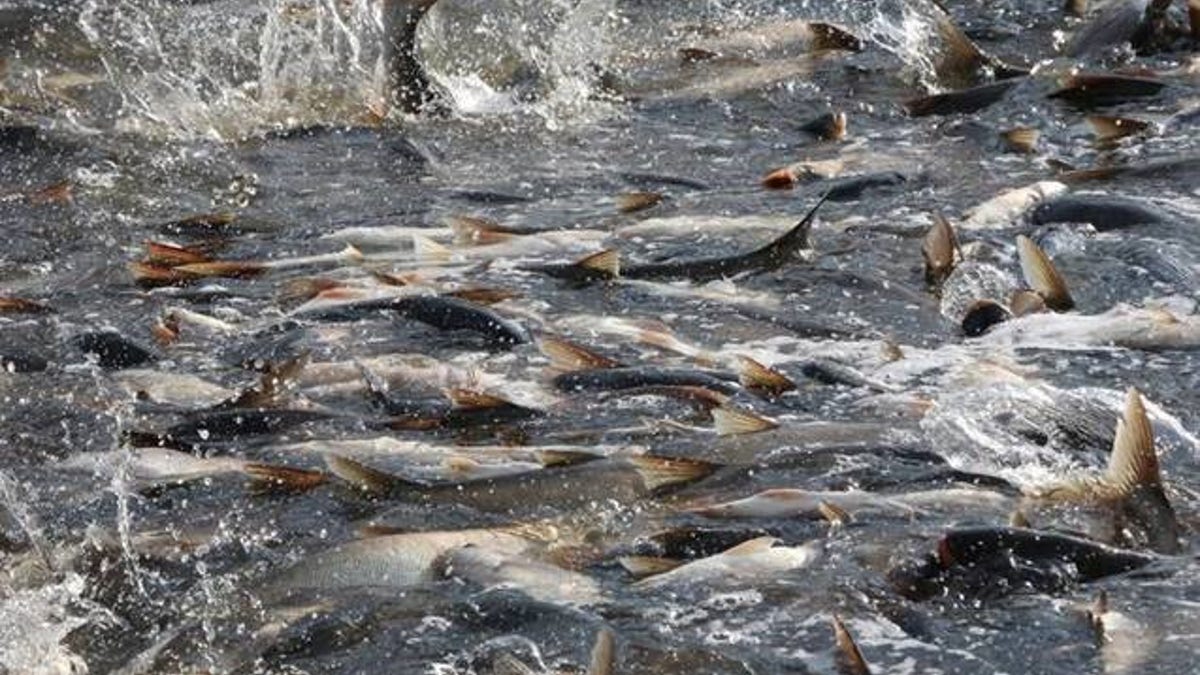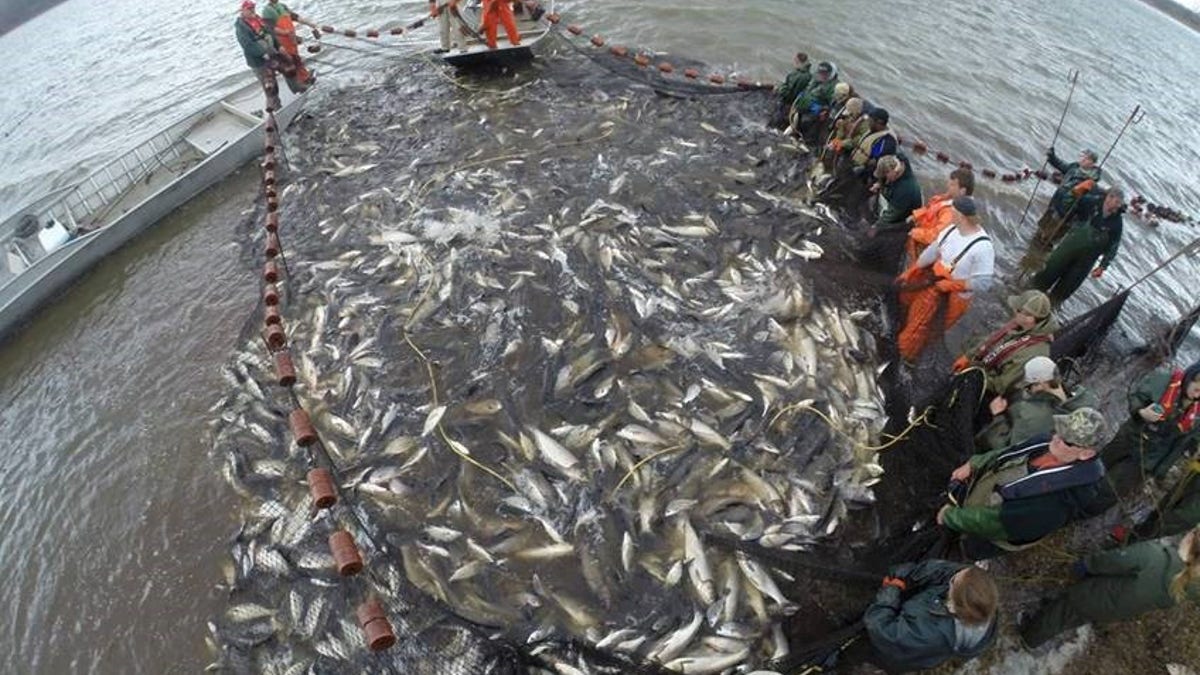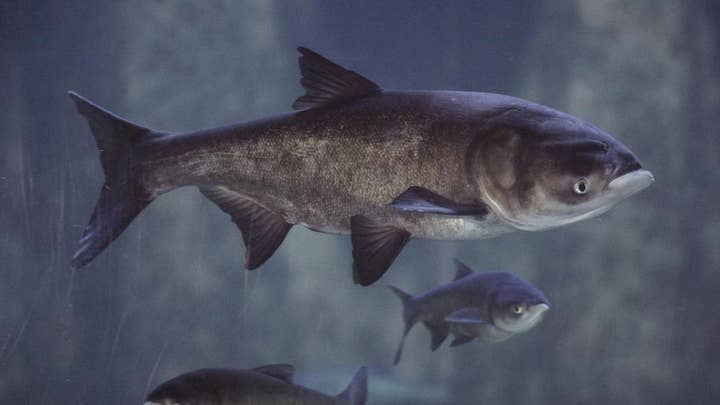
Asian Carp first arrived in North America in the 1960s. They were brought in from Southeast Asia to control algae and parasites in fish farming ponds in Louisiana and other southern states. But the plan quickly got out of hand. ( Illinois Department of Natural Resources)
Asian Carp has been deemed the enemies of America’s waterways, threatening to take over the Great Lakes and cause a disaster to the country’s ecosystem.
Now, the battle against the invasive fish is becoming more aggressive, more expensive and more desperate.
Engineers and ecologists have come up with a variety of ways to combat the growing threat.
Illinois has sent in a team of “Carp Cowboys” to rustle up and herd the fish out of the water.
Electric barriers have been set up in three different locations to block them from reaching Lake Michigan.
And the Army Corps of Engineers is proposing a high-tech infrastructure plan to defend the waterways called “The Brandon Road Lock and Dam” project.
Army Corps spokesman Allen Marshall explained it as a navigation structure on the Illinois Waterway that could be used as a “…potential one-way choke point to stop the spread of aquatic nuisances like Asian Carp” and prevent them from traveling out from the Mississippi River Basin toward Lake Michigan.
MICHIGAN'S ASIAN CARP CHALLENGE SEEKS IDEAS TO KEEP KILLER FISH OUT OF GREAT LAKES
What’s involved are things like noise-making machines to scare the fish, an air bubble curtain and an electric barrier.
The project would cost nearly $800 million, with about 65 percent funded by the federal government, if Congress approves the money. The remaining 35 percent would come from states that surround the Great Lakes.

Asian Carp has been deemed the enemies of America’s waterways, threatening to take over the Great Lakes and cause a disaster to the country’s ecosystem. (Illinois Department of Natural Resources)
The Army Corps is expected to present the proposal to Congress at the end of February, but the government shutdown could delay it.
Asian Carp first arrived in North America in the 1960s. They were brought in from Southeast Asia to control algae and parasites in fish farming ponds in Louisiana and other southern states.
But the plan quickly got out of hand.
Heavy rains and flooding allowed the species to escape into larger waterways.
“Since then, they’ve been making their way north toward the Great Lakes looking for food and new places to inhabit,” explained Joel Brammeier, president of The Alliance for The Great Lakes.
ASIAN CARP FOUND NEAR LAKE MICHIGAN GOT PAST BARRIERS
The fish have become the bullies of the waterways, wreaking havoc on lakes and rivers wherever they go. They’re able to dominate their domains because they eat most of the plankton and algae, leaving little for the native fish.
While there are 10 different types of Asian Carp in the world, there are just four infesting U.S. and Canadian waters: black carp, grass carp, bighead carp and silver carp.

What makes these hardy species so unique, and maybe even a bit scary, is that they can jump out of the water, as high as 10 feet in the air. Boaters have been hit by the flying fish, which can weigh up to 100 pounds and cause serious damage. (Army Corp of Engineers)
”…All are fast-growing and prolific feeders that out-compete native fish and can leave a trail of environmental destruction in their wake,” according to the government website www.asiancarp.us
What makes these hardy species so unique, and maybe even a bit scary, is that they can jump out of the water, as high as 10 feet in the air.
Boaters have been hit by the flying fish, which can weigh up to 100 pounds and cause serious damage.
“They’ve broken noses and even knocked some people unconscious when they’ve been hit in the head,” said Kevin Irons of the Illinois Department of Natural Resources.
Irons admits he’d been bruised more than a few times when a carp flung its body in his direction. The jumping is a reaction to the carp getting nervous or frightened, Irons explained. Their intention is to jump away and confuse a predator.
“It’s a flight or fight response,” he said.
Some recreational boating areas are now deemed unsafe due to the Asian carp.
“The impact to the $7 billion Great Lakes sport-fishery would be even more extensive than just the big lakes…” said Drew Youngdyke with the National Wildlife Federation,
“because inland rivers and lakes connected to the Great Lakes would also be adversely affected.”
There have been a lot of different efforts over the years to block the dangerous fish.
STOP ASIAN CARP, EARN $1 MILLION
The “Carp Cowboys”, who are professional fishermen, have developed unique ways to herd the fish and remove them by banging on their boats and revving their motors. The Asian Carp react to the noise by either jumping out of the water or swimming away, which makes them easier to catch.
“It’s much more efficient than just using a net,” said Irons.
The Illinois Department of Natural Resources even attached tiny radios to some carp in order to track their movement and be better able to hunt them down.
And Irons had another idea about what to do with Asian carp – eat them.
“They’re delicious!” he said. “And by harvesting we can get the populations down to a fraction of where they are today.”
The fish are actually eaten by people around the world, but although some restaurant owners in Chicago have tried to serve up the delicacy, it hasn’t caught on yet in the United States.
“It’s a white, flaky meat,” Irons said, “you can grill it or sauté it.”
